The operations of your business can be defined as the sum of all the daily activities that you and your team execute to create products or services and engage with your customers, among other critical business functions. While organizing these moving parts might sound difficult, it can be easily done by writing a business operational plan. But before we learn how to make one, let’s first understand what’s the relationship between strategic and operational planning.
Operational Planning vs. Strategic Planning
Operational planning and strategic planning are complementary to each other. This is because strategic plans define the business strategy and the long-term goals for your organization, while operational plans define the steps required to achieve them.
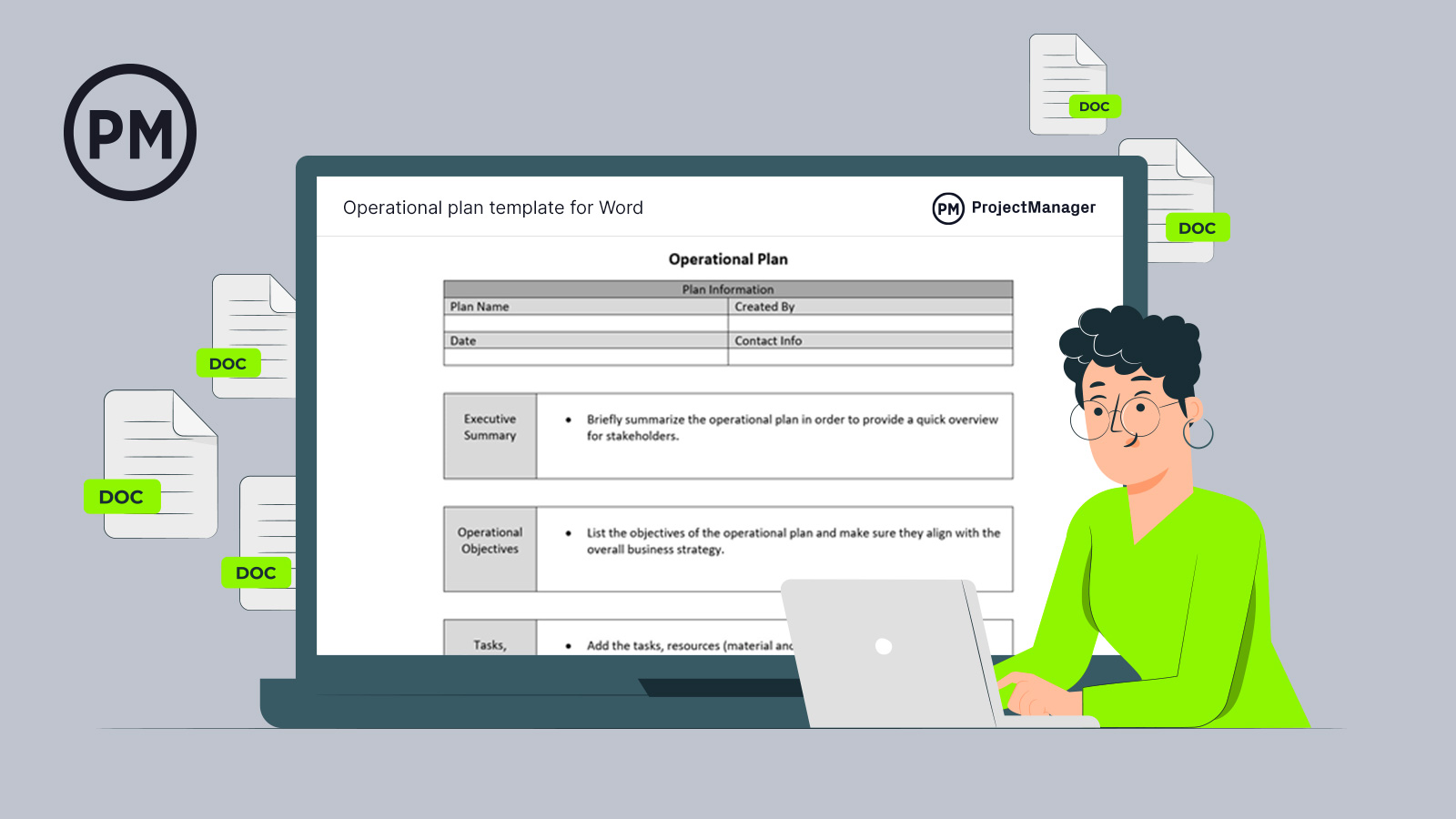
Get your free
Operational Plan Template
Use this free Operational Plan Template for Word to manage your projects better.
What Is a Strategic Plan?
A strategic plan is a business document that describes the business goals of a company as well as the high-level actions that will be taken to achieve them over a time period of 1-3 years.
What Is an Operational Plan?
Operational plans map the daily, weekly or monthly business operations that’ll be executed by the department to complete the goals you’ve previously defined in your strategic plan. Operational plans go deeper into explaining your business operations as they explain roles and responsibilities, timelines and the scope of work.
Put an Operational Plan Online With ProjectManager
Operational plans work best when using project management software to faciliate communication across departments. ProjectManager is award-winning project and portfolio software with robust Gantt charts to plan, manage and track plans in real time.
- Set a baseline and track metrics on dashboards and reports to meet benchmarks
- Filter for the critical path instantly and identify essential tasks
- Link all four types of task dependencies to avoid costly delays. Try it Free
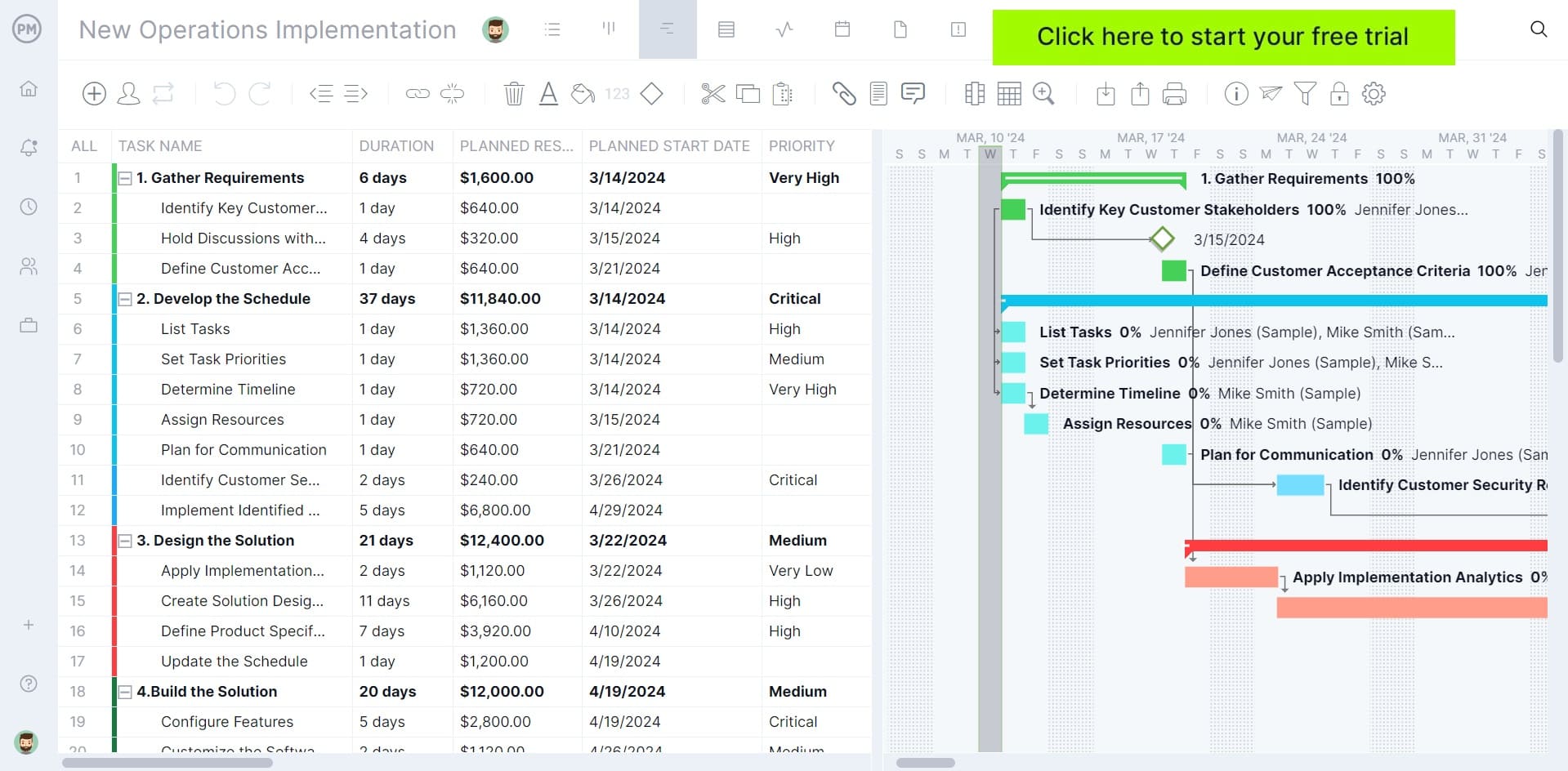
What Is Operational Planning?
Operational planning is the process of turning strategic plans into action plans, which simply means breaking down high-level strategic goals and activities into smaller, actionable steps. The main goal of operational planning is to coordinate different departments and layers of management to ensure the whole organization works towards the same objective, which is achieving the goals set forth in the strategic plan.
How to Make an Operational Plan
There’s no single approach to follow when making an operation plan for your business. However, there’s one golden rule in operations management: your strategic and operational plans must be aligned. Based on that principle, here are seven steps to make an operational plan.
- Map business processes and workflows: What steps need to be taken at the operations level to accomplish long-term strategic goals?
- Set operational-level goals: Describe what operational-level goals contribute to the achievement of larger strategic goals.
- Determine the operational timeline: Is there any time frame for the achievement of the operational plan?
- Define your resource requirements: Estimate what resources are needed for the execution of the operational plan.
- Estimate the operational budget: Based on your resource requirements, estimate costs and define an operational budget.
- Set a hiring plan: Are there any skills gaps that need to be filled in your organization?
- Set key performance indicators: Define metrics and performance tracking procedures to measure your team’s performance.
Free Operational Plan Template
Leverage everything you’ve learned today with our template. This free operational plan template for Word will help you define your budget, timeline, KPIs and more. It’s the perfect first step in organizing and improving your operations. Download it today.
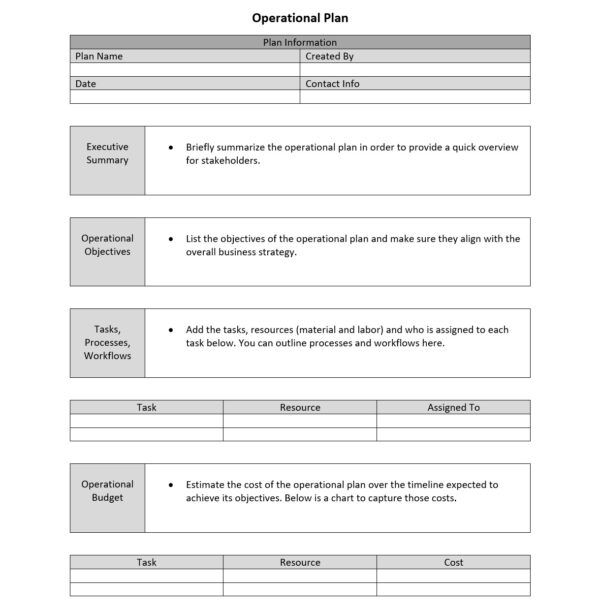
What Should be Included in an Operational Plan?
Your operational plan should describe your business operations as accurately as possible so that internal teams know how the company works and how they can help achieve the larger strategic objectives. Here’s a list of some of the key elements that you’ll need to consider when writing an operational plan.
Executive Summary
An executive summary is a brief document that summarizes the content of larger documents like business plans, strategic plans or operation plans. Their main purpose is to provide a quick overview for busy stakeholders.
Operational Budget
An operational budget is an estimation of the expected operating costs and revenues for a given time period. As with other types of budget, the operational budget defines the amount of money that’s available to acquire raw materials, equipment or anything else that’s needed for business operations.
It’s important to limit your spending to stay below your operational budget, otherwise, your company could run out of resources to execute its normal activities. You can use our free operating budget template for Excel to track your operating costs.
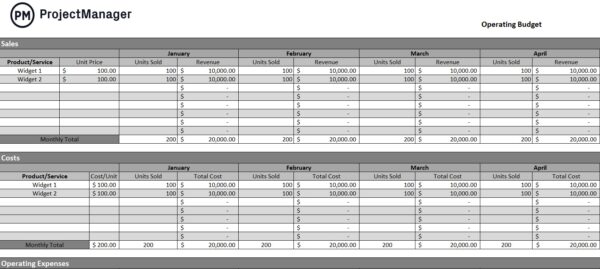
Operational Objectives
It’s essential to align your operational objectives with your strategic objectives. For example, if one of your strategic objectives is to increase sales by 25 percent over the next three years, one possible operational objective would be to hire new sales employees. You should always grab your strategic plan objectives and turn them into one or multiple action items.
Processes & Workflows
Explain the various business processes, workflows and tasks that need to be executed to achieve your operational objectives. Make sure to explain what resources are needed, such as raw materials, equipment or human resources.
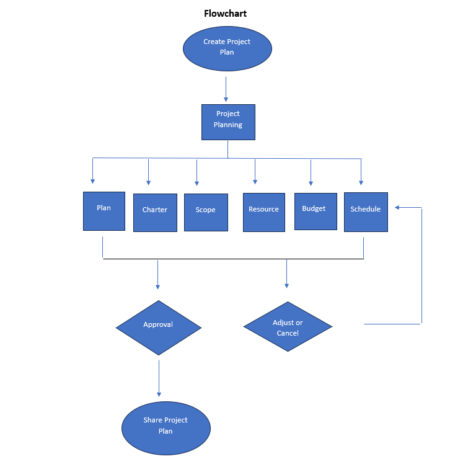
Operational Timeline
It’s important to establish a timeline for your operational plan. In most cases, your operational plan will have the same length as your strategic plan, but in some scenarios, you might create multiple operational plans for specific purposes. Not all operational plans are equal, so the length of your operational timeline will depend on the duration of your projects, workflows and processes.
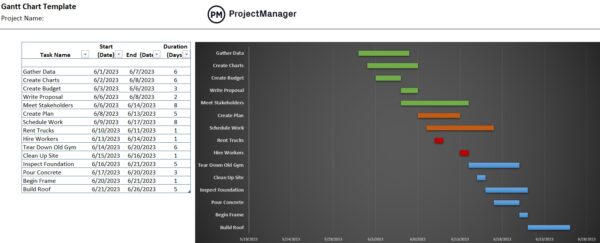
Hiring Plan
Find any skills gap there might be in your team. You might need to hire a couple of individuals or even create new departments in order to execute your business processes.
Quality Assurance and Control
Most companies implement quality assurance and control procedures for a variety of reasons such as customer safety and regulatory compliance. In addition, quality assurance issues can cost your business millions, so establishing quality management protocols is a key step in operational planning.
Key Performance Indicators
It’s important to establish key performance indicators (KPIs) to measure the productivity of your business operations. You can define as many KPIs as needed for all your business processes. For example, you can define KPIs for marketing, sales, product development and other key departments in your company. This can include product launch deadlines, number of manufactured goods, number of customer service cases closed, number of 5-star reviews received, number of customers acquired, revenue increased by a certain percentage and so on.
Risks, Assumptions and Constraints
Note any potential risks, assumptions and time or resource constraints that might affect your business operations.
What Are the Benefits of Operational Planning?
Every plan has a massive effect on all team members involved, and those can be to your company’s benefit or to their detriment. If it’s to their detriment, it’s best to find out as soon as possible so you can modify your operational plan and pivot with ease.
But that’s the whole point of operational planning: you get to see the effect of your operations on the business’s bottom line in real time, or at every benchmark, so you know exactly when to pivot. And with a plan that’s as custom to each department as an operational plan, you know exactly where things go wrong and why.
How ProjectManager Can Help with Operational Planning
Creating and implementing a high-quality operational plan is the best way to ensure that your organization starts out a project on the right foot. ProjectManager has award-winning project management tools to help you craft and execute such a plan.
Gantt charts are essential to create and monitor operational plans effectively. ProjectManager helps you access your Gantt chart online so you can add benchmarks for operational performance reviews. You can also create tasks along with dependencies to make the operation a surefire success.
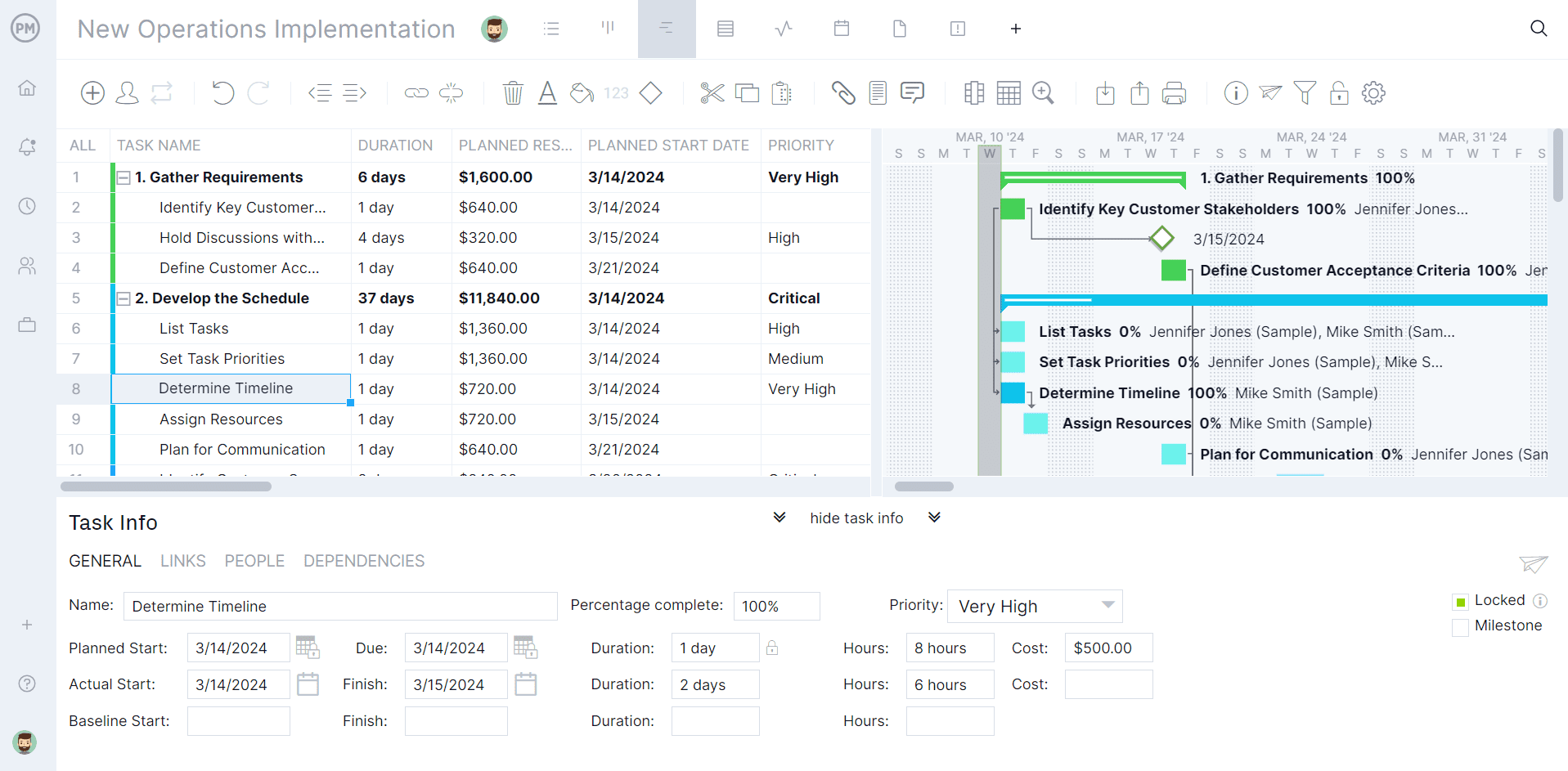
Whether you’re a team of IT system administrators, marketing experts, or engineers, ProjectManager includes robust planning and reporting tools. Plan in sprints, assign due dates, collaborate with team members and track everything with just the click of a button. Plus, we have numerous ready-made project reports that can be generated instantly, including status reports, variance reports, timesheet reports and more.
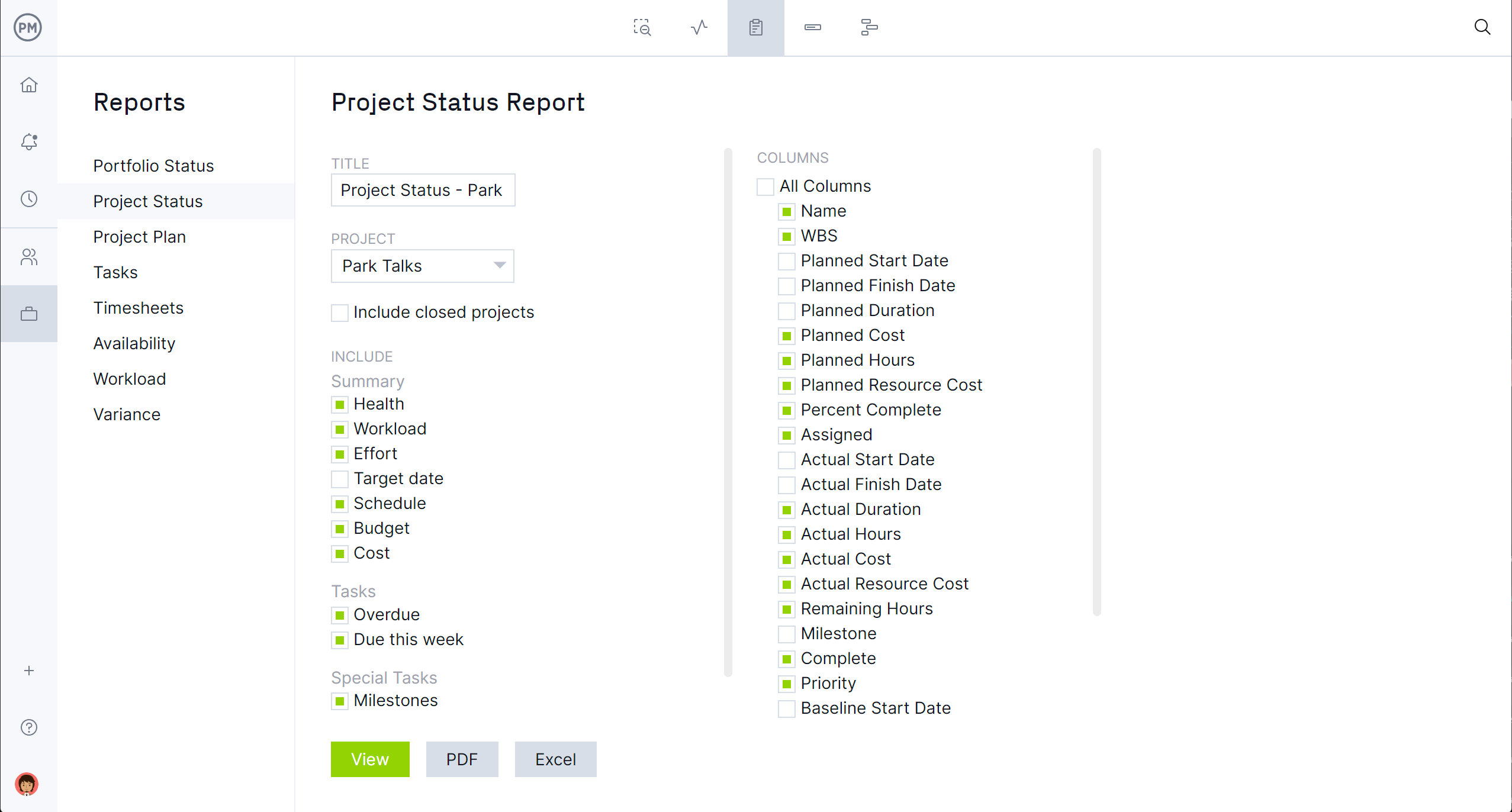
Related Operations Management Content
- Operational Strategy: A Quick Guide
- Operations Management: Key Functions, Roles and Skills
- Operational Efficiency: A Quick Guide
- Using Operational Excellence to Be More Productive
Operational planning isn’t done in a silo, and it doesn’t work without the full weight of the team backing it up. Ensure that your department is successful at each benchmark. ProjectManager is an award-winning pm software dedicated to helping businesses smooth out their operational plans for a better year ahead. Sign up for our free 30-day trial today.

